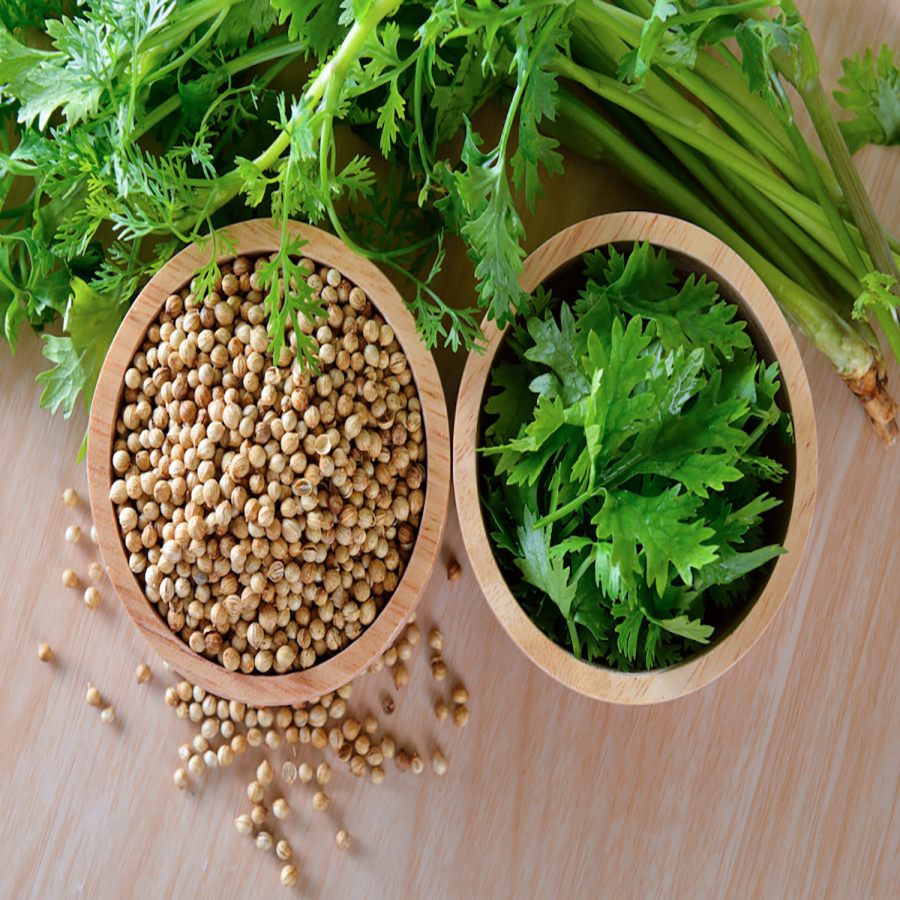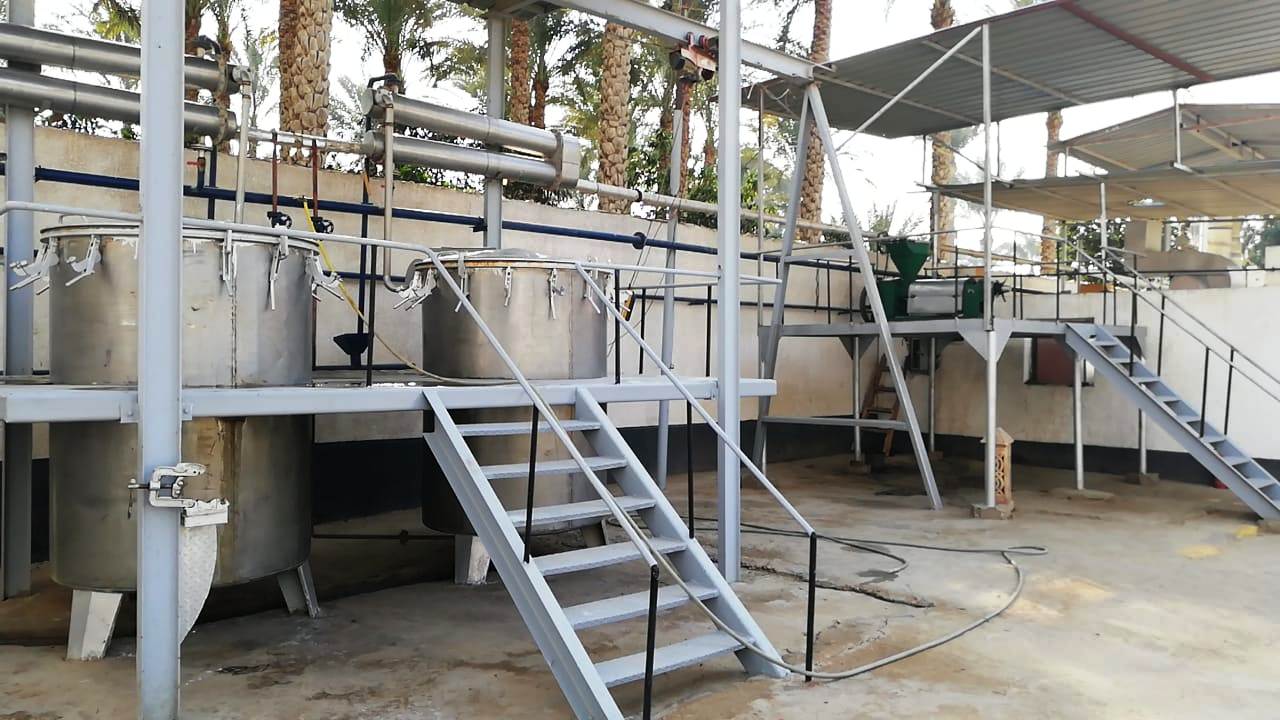Coriander Coriandrum sativum Essential Oil (Seed & Herb)
Login to view prices
Common name: Coriander.
Latin name: Coriandrum sativum L.
Family: Apiaceae (Umbelliferae)
Other names: Arab: kuzbara, kuzbura; Armenian:chamem; Chinese: yuan sui, hu sui; Czech: koriandr; Danish: koriander; Dutch: koriander; English: coriander, collender, chinese parsley; Ethiopian: (Amharic) dembilal; French: coriandre, persil arabe; Georgian (Caucasus): kinza, kindza, kindz; German: Koriander, Wanzendill, Schwindelkorn; Greek: koriannon, korion; Hindi: dhania, dhanya; Hungarian: coriander; Italian: coriandolo; Japanese: koendoro; Malay: ketumbar; Persian: geshnes; Polish: kolendra; Portugese: coentro; Rumanian: coriándru; Russian: koriandr, koljandra, kišnec, kinza, vonjučee zel’e, klopovnik; Sanskrit: dhanayaka, kusthumbari; Serbokroatian: korijander; Spanish: coriandro, cilantro, cilandrio, culantro; Swiss: Chrapfechِörnli, Böِbberli, Rügelikümmi; Turkish: kişniş
Botanical Origin:
Common name: Coriander.
Latin name: Coriandrum sativum L.
Family: Apiaceae (Umbelliferae)
Other names: Arab: kuzbara, kuzbura; Armenian:chamem; Chinese: yuan sui, hu sui; Czech: koriandr; Danish: koriander; Dutch: koriander; English: coriander, collender, chinese parsley; Ethiopian: (Amharic) dembilal; French: coriandre, persil arabe; Georgian (Caucasus): kinza, kindza, kindz; German: Koriander, Wanzendill, Schwindelkorn; Greek: koriannon, korion; Hindi: dhania, dhanya; Hungarian: coriander; Italian: coriandolo; Japanese: koendoro; Malay: ketumbar; Persian: geshnes; Polish: kolendra; Portugese: coentro; Rumanian: coriándru; Russian: koriandr, koljandra, kišnec, kinza, vonjučee zel’e, klopovnik; Sanskrit: dhanayaka, kusthumbari; Serbokroatian: korijander; Spanish: coriandro, cilantro, cilandrio, culantro; Swiss: Chrapfechِörnli, Böِbberli, Rügelikümmi; Turkish: kişniş
Description:
Coriandrum sativum L is an annual hapaxanthic bright green herb with erect and glabrous (hairless) branching stem, growing to a height of about 2 ft. and carrying compound leaves. The compound lower leaves are roundish and lobed, while the upper leaves are finely divided into very narrow, lacy segments. At flowering, the glabrous plant can reach heights between 0.20 and 1.40 m.
The small flowers, which appear in june, are white or rose colored; the fruit is globular and composed of two concavo-convex mericarps. The fruit, or, as it is commercially called, the seed, ripens in August.
The overground parts of the green plant, particularly the leaves, possess a peculiar rather disagreeable odor. However a pleasant, warm, somewhat spicy aroma distinguishes the mature dried seed.
Range & Habitat:
The world-wide production of coriander may be estimated at approximately 550,000 ha annually. The yearly production of coriander fruits may be estimated at about 600,000 tons. The main producers of coriander fruits are the Ukraine, Russia, India, Morocco, Argentina, Mexico and Romania. Other countries that produce at least some coriander for use of the fruits, by geographical region, are:
– the Near East (Iran, Israel, Kuwait, Lebanon, Syria and Turkey)
– the Middle East (Bhutan, Kasachstan, Kirgysia, Pakistan and Tadjikistan)
– the Far East (Burma, China and Thailand)
– the Americas (Argentina, Chile, Costa Rica, Guatemala, Paraguay, USA and
Canada)
– Africa (Algeria, Egypt, Ethiopia, Somalia and Tunisia)
– Europe (Bulgaria, Czechoslovakia, England, France, Hungary, Italy, the Netherlands,
Poland and Yugoslavia).
Coriander is well suited to growing on a range of soils, but it performs best on well-drained loam and sandy-loam soils. Suitable pH ranges are from 4.5 to 8.0, with an optimum of 6.3. Although the crop is heat loving, it has an optimum growing temperature of 18° C.
The large-seeded coriander requires a shorter time to maturity than the small-seeded cilantro. Hot, dry winds during flowering (anthesis) can lead to the dropping of flowers, resulting in substantial yield reduction.
Researchers in Europe have noted that the quantity of oil increases as production occurs farther north in the northern hemisphere. It has also been noted that volatile oil content increases during cool, moist summers. The use of honeybees as pollinators can improve coriander seed yield.
The reported life zone of coriander is 7 to 27° C with an annual precipitation of 0.3 to 2.6 meters and a soil pH of 4.9 to 8.3. Coriander thrives in full sun and grows best in deep fertile loams with adequate drainage. The plant is tolerant to cold, heat and drought stresses. Coriander adapts itself easily to any kind of soil.
Planting & Cultivation:
Row spacing can be 6 to 12 in. (15 – 30 cm) with a seeding depth of 1 to 1.5 in. (2.5 – 4.0 cm). Time of sowing can vary between late-April and mid-May or even at March benefiting from the winter humidity of the soil. Sowing can be done with conventional equipment, but press drills appear to produce the best results on a moist, firm seedbed when the danger of frost is over. It is critical that seeding be done on an absolutely clean weed free field because the crop may take a long time to emerge. The seeds germinate well and evenly within 8 to 10 days.
The seeding rate for coriander production is generally 13 to 22 lb/ac (15 – 25 kg/ha), with 19 lb/ac being the optimal rate.
The cultural care begins right after sprouting of the seed. At first the young plants develop very slowly but as soon as they have taken root they grow almost visibly. After the plants have reached a height of about one span (23 cm) they are hoed for the second time. From then on the plants grow rapidly, the leaves protecting the ground around the plants so well that further care is not necessary. If the seed is sown at a greater row distance, e.g. 36 – 37 cm., a cultivator can be used instead a hoe.
When not yet matured, coriander has a strong, peculiar, and disagreeable odor.
Harvesting and Preparing for the Market:
Coriander should be swathed when 80 per cent of the seeds turn purple-brown. Swathes should not be left out too long due to the potential for shattering. Swathing when there is dew or high humidity will reduce shattering losses.
Combining is usually done when seed moisture content is less than 15 per cent. Ten per cent moisture is considered dry, but buyers prefer nine per cent. Cylinder/rotor speeds should be set at approximately 500 rpm under dry conditions. An initial setting of 0.5 in. (20 mm) at the front and 0.25 in. (10 mm) at the back is suggested. Wind speed should be reduced to the minimum, and ground speed should be slowed.
Coriander oil is very volatile, so the seed must be dried gently; avoid hot air drying. Aeration is useful for reducing moisture content; however, coriander seed readily takes up other odors, so store away from gasoline, herbicides, etc. Remove green material such as weed seeds as quickly as possible, since aeration will be diverted around these areas in the storage bin, resulting in the potential for spoilage.
The sample must be free of rodent droppings and have very low foreign material (2 per cent). If samples have greater that 5 per cent split fruit, the shipment is usually discounted by the buyer.
Yield of seed per Acre:
350 to 850 Kg of coriander seeds are produced per acre.
Method of Extraction:
By Steam Distillation.
- Coriander Seed Oil:
Analysis of the seed showed 1.4 to 1.7 % of volatile oil, and 12 to 12.4 % of fatty oil. However the oil yield ranges from 0.4 to 1.1 % for crushed Hungarian coriander seed; on the average it runs from 0.5 to 0.6 %.
Some people found that coriander attains its greatest yield of volatile oil (0.91 %) with a growing period of 110 – 122 days in cool, somewhat damp weather.
Grinding of the seeds is very essential prior to distillation, this results in increased yield of oil by 17 %, and saving at the same time 10 to 15 % of steam; with crushed seeds the distillation lasts for 3 to 4 hrs instead of 12 to 15 hrs in the case of the whole seed.
After grinding the seed, it has to be distilled immediately; otherwise a considerable part of the oil will be lost by evaporation
The oil content depends primarily upon the quality of the soil. It is influenced also by the state of ripeness, unripe or half-ripe seeds giving not only abnormally low yields but also oils of inferior and disagreeable odor.
In general smaller coriander seed contains more essential oil than larger sized seed does.
- Coriander Herb Oil:
It appears that the entire plant can be used for distillation since stalks and leaves yield considerable oil (0.95 %).
- Fresh, flowering whole plants yielded 0.12 % of oil.
- Fresh, semimatured herb, with seed yielded 0.17% of oil.
- Mature seed, distilled immediately after the harvest yielded 0.83 % of the oil.
Oils distilled from the overground parts of coriander, including unripened seed, have a very peculiar, quite disagreeable odor, totally different from that of the seed oil.
It is absolutely impossible to use leaf oil instead of seed oil in any flavor, perfume, or pharmaceutical formula. The leaf or herb oil has a pronounced odor of decylaldehyde or other higher fatty aldehydes; in fact, the leaf oil contains so large an amount of higher aliphatic aldehydes that it might almost be considered as a source of these compounds, should price of the oil permit.
[1] Source: Simon, J.E., A.F. Chadwick and L.E. Craker. 1984. Herbs: An Indexed Bibliography. 1971-1980. The Scientific Literatureon Selected Herbs, and Aromatic and Medicinal Plants of the TemperateZone. Archon Books, 770 pp., Hamden, CT. The Essential Oils. By Ernest Guenther. 1950
Action, Medical Uses, and Dosage.—Coriander is a stimulant and carminative, and is employed in medicine as an adjuvant or corrigent. Its dose is from 20 to 60 grains.
Action, Medical Uses, and Dosage.—This oil is carminative, aromatic, and anodyne. It may be used locally for neuralgic and rheumatic pains, and internally for flatulent colic, cramps, etc. It gives an agreeable flavor to many medicines, senna in particular. Dose, from 1 to 5 drops.
Adulteration & its Detection:
The oil is subject to much adulteration, especially with:
| Adulterant | Appropriate method for detection | Notes |
| Oil of orange | lowering of the specific gravity, increase in rotatory power, and imperfect solubility | |
| Other adulterants are the oils of cubebs, cedar, and turpentine |
Additional information
| Weight | N/A |
|---|---|
| Dimensions | N/A |
| Oil Purity | 100% Natural & Pure without any chemical, flavor, food additive or carrier. |
| Type | Coriander Herb Oil, Coriander Seed Oil |
| Ship from | Egypt |
| Country of Origin | Egypt |
| Cultivation Type | Organic, Conventional |
| Oil Bulk Packaging | 25 kg HDPE Plastic Jerrycan, 50 kg HDPE Plastic drum |
| HS Code | 33012914 |
| CAS Number | 8000-42-8 |
| Oil Documentation Available | Allergen Free Certificate, Bovine Spongiform Encephalophathy (BSE) Certificate, Certificate of Analysis (COA), GMO Certificate, GRAS Status Statement, Halal Certificate, Herbal Origin Statement, KOSHER Certificate, Manufacturing Flow Chart, Material Safety Data Sheet (MSDS), Organic Certificate, Pesticide Residual Certificate, Researches & Studies, Technical Data Sheet (TDS), WADA Prohibited list Statement |
-
Login to view prices
-
Login to view prices
-
Login to view prices
Jasmine Infused Oil (Natural Jasmine oil or flowers infused in Carrier Oil)
Login to view prices Read more -
Login to view prices
-
Login to view prices
-
Login to view prices







